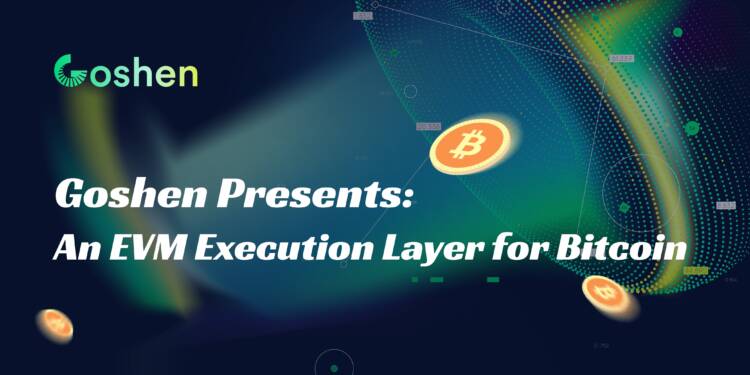Goshen’s development team has unveiled an innovative proposal in anticipation of the upcoming Bitcoin 2023 conference. Inspired by both Ordinals and the BRC-20 protocol’s recent popularity, they aim to introduce a transformative solution for Bitcoin. This groundbreaking initiative involves integrating an Ethereum Virtual Machine (EVM) execution layer into the Bitcoin network, presenting numerous advantages.
One notable advantage is the utilization of Bitcoin’s SigWit mechanism, which results in lower dApp transaction fees compared to Ethereum. Moreover, Goshen’s protocol distinguishes itself from Ordinals by streamlining the process of data upload, eliminating the need for two separate transactions (commit and reveal). This simplification enhances user experience and facilitates toolchain construction.
Furthermore, Goshen’s protocol ensures efficient control over assets deployed in the EVM, eliminating the necessity for split transactions commonly associated with BRC-20 tokens, even for basic transfers. Additionally, it offers seamless compatibility with the Ethereum ecosystem, eliminating the need for the redevelopment of off-chain toolchains.
With these remarkable advancements, Goshen‘s groundbreaking initiative sets the stage for a significant transformation in the capabilities of Bitcoin, positioning it as a formidable contender in the realm of smart contracts and decentralized applications (dApps).
Overcoming Bitcoin’s Functional Limitations
Bitcoin, while equipped with a scripting language, faces certain limitations in its functionality when compared to platforms like Ethereum, which offer robust smart contract capabilities. This disparity hampers the range of applications that can be built on the Bitcoin network.
Fortunately, the Segregated Witness (SegWit) protocol upgrade has enhanced Bitcoin’s capacity and substantially decreased transaction fees. As a result, a compelling need emerged to develop an EVM execution application layer for Bitcoin, enabling users to interact directly with EVM smart contracts within the Bitcoin network.
Enabling Innovative Design
The implementation of the Segregated Witness protocol serves the purpose of reducing transaction fees associated with Bitcoin. This protocol allows users to initiate Bitcoin transactions from a unique Pay-to-Witness-Script-Hash (P2WSH) address. Notably, the protocol enables the encoding of EVM, invoking transaction data within the witness data.
A noteworthy aspect of Goshen’s distinctive redeem script is that it first eliminates the invoke data from the witness data stack, subsequently functioning like a regular redeem script. This approach differs from the Ordinals protocol, which directly encodes data in the script and necessitates both a commit and a reveal transaction. Goshen’s protocol offers improved user-friendliness by ensuring the stability of the P2WSH address and facilitating the data reveal process within a single transaction.
Introducing Seamless EVM Execution
Goshen’s comprehensive solution comprises several key components: a dedicated format for EVM data, the utilization of an EVM-enabled Pay-to-Witness-Script-Hash (P2WSH) in version 0, and the seamless execution of the EVM. Notably, Goshen’s EVM P2WSH implementation ensures stability, enabling the direct revelation of data within a single transaction, in contrast to the Ordinals protocol.
Moreover, the execution of the EVM within the Goshen solution does not impose any additional fees. To mitigate the risk of Distributed Denial-of-Service (DDoS) attacks, Goshen has implemented a cap of 10,000,000 on the execution gas. These measures collectively enhance Goshen’s solution’s reliability, security, and efficiency.
Complementing Bitcoin’s Existing Protocols and Applications
Goshen’s protocol is meticulously designed to be independent and complementary to other facets of the Bitcoin protocol. Its unique feature is its ability to seamlessly integrate with various layer one and layer applications without requiring any modifications to blocks, transactions, or network protocols.
As a result, Goshen’s protocol can be readily adopted or disregarded without causing any disruption to existing users. Its compatibility and flexibility make it a viable choice for immediate implementation or a deliberate decision to be made in the future.
Enabling Backward Compatibility for Easy Integration
Goshen’s protocol stands out for its complete backward compatibility, requiring no alterations to the existing Bitcoin network. This groundbreaking solution brings the advantages of Ethereum’s Ethereum Virtual Machine to the Bitcoin community. By taking this significant leap, Goshen aims to unlock a new realm of growth and progress for both the Bitcoin network and its users.
Understanding Goshen’s EVM Layer
The new layer will incorporate two distinct types of EVM invoke actions: EVM call and EVM deploy.
1. EVM Address
Goshen ensures compatibility with the Ethereum ecosystem by deriving the EVM address from the redeem script hash. While the redeem script hash consists of 32 bytes, the EVM address is represented by only 20 bytes. This derivation process involves taking the ripemd160 of the script hash, allowing seamless integration and interoperability with the existing Ethereum infrastructure.
2. EVM Data Format
Goshen’s EVM Call and Deploy operations involve specifying the From Address, To Address, and Data parameters. Subsequently, these call and deployment actions are converted into witness data, which is encoded appropriately. This step holds great significance as it guarantees that the encoded data size remains within the permissible limits, ensuring the transactions maintain their integrity and efficiency.
3. EVM P2WSH
The redeem script for EVM is an extended version of the standard redeem script, with a series of DROP opcodes appended to it. The provided examples showcase the utilization of an EVM-enabled version 0 Pay-to-Witness-Script-Hash (P2WSH) and an EVM-enabled 1-of-2 multi-signature version 0 P2WSH. These demonstrations highlight the versatility and functionality of the extended redeem script in enabling EVM capabilities within the Bitcoin network.
4. EVM Execution
As a precautionary measure against potential Distributed Denial-of-Service (DDoS) attacks, the execution of the EVM does not incur additional fees. Nevertheless, there is a cap on the execution gas, which is set at 10,000,000. This limitation ensures a balanced and secure execution environment while mitigating the risk of abuse or excessive resource consumption.
5. Terminology and Notation
Goshen’s groundbreaking solution introduces several novel terms and concepts that are integral to Bitcoin’s EVM layer. These include EVM addresses, EVM data formats, EVM P2WSH, and EVM execution. Each of these elements plays a crucial role within the EVM execution layer, serving distinct functions and contributing to the overall functionality of the system.
Final Thoughts
Goshen’s Layer2 solution introduces a groundbreaking EVM execution layer for Bitcoin, marking a pivotal moment in its development and expanding the range of functionalities and possibilities available to users. Drawing inspiration from Ordinals and the BRC-20 protocol, this solution capitalizes on Bitcoin’s SegWit mechanism and taps into the Ethereum ecosystem.
Crucially, this protocol has been meticulously designed to seamlessly integrate with the existing Bitcoin network, enabling users to adopt it immediately without any disruption to their current operations. The Goshen team is confident that this innovative solution will propel Bitcoin to unprecedented heights, enhancing the capabilities of its scripting language and providing a more efficient and user-friendly environment for application development. With this significant stride, Goshen expresses its enthusiasm for the future of Bitcoin and its continuous evolution.






















